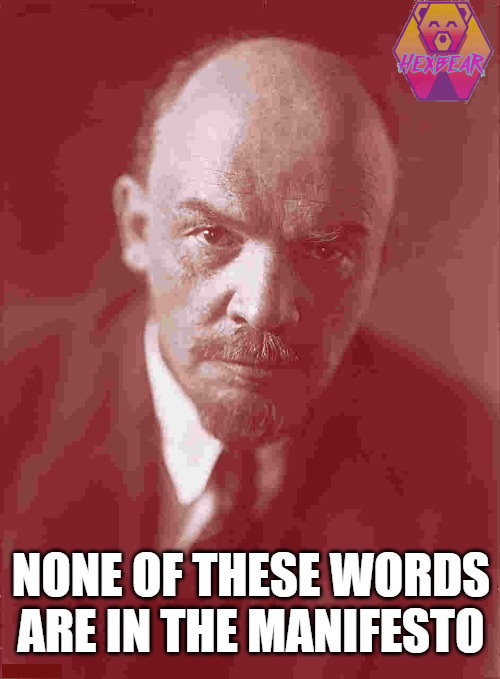Edit for clarity: I’m not asking why the Tankie/Anarchist grudge exist. I’m curious about what information sources - mentors, friends, books, TV, cultural osmosis, conveys that information to people. Where do individuals encounter this information and how does it become important to them. It’s an anthropology question about a contemporary culture rather than a question about the history of leftism.
I’ve been thinking about this a bit lately. Newly minted Anarchists have to learn to hate Lenin and Stalin and whoever else they have a grudge against. They have to encounter some materials or teacher who teaches them “Yeah these guys, you have to hate these guys and it has to be super-personal like they kicked your dog. You have to be extremely angry about it and treat anyone who doesn’t disavow them as though they’re literally going to kill you.”
Like there’s some process of enculturation there, of being brought in to the culture of anarchism, and there’s a process where anarchists learn this thing that all (most?) anarchists know and agree on.
Idk, just anthropology brain anthropologying. Cause like if someone or something didn’t teach you this why would you care so much?


The Soviet invasion of Hungary was good and based and one of the few correct things Khrushchev did. It’s worth bearing in mind the uprising in Hungary coincided with Israel, France and UK’s attack on Egypt.
It was a mix of a popular uprising against Khrushchevs faked “secret” speech about Stalin which enabled the fascist elements (paid, armed and trained by US and UK) of Hungarian society to gamble their chance on getting rid of socialist rule.
Fascists marked Communists homes with a white cross and those of jews with a black cross for extermination squads:
(Herbert Apheker, The Truth About Hungary, p.220)
CIA sent terrorists to Hungary under the RED SOX program (Horthy here was the leader of the Hungarian fascists under 23 years of fascist rule in Hungary until Soviet liberation).
(James Jesus Angleton, the CIA, and the Craft of Counterintelligence, by Michael Howard Holzman, pp. 150-160)
(ibid)
(MI6 trained rebels to fight Soviets in Hungarian revolt, The Independent)
Hungary, in 1954, was considered a “weak spot” of the Soviet Union according to US committee ’
(Truth About Hungary p.112)
USA was planning on WW3 with Soviet Union in 1943 (2 years before WW2 ended) whilst the British - at war with Hungary at this time “looked on at favour of Horthy” (Horthyism was the brand of fascism in Hungary in power for 23 years prior to Soviet liberation which was only more and more influenced by Nazism as the alliance with Austria and Germany deepened during that period and was to be the main fighting force in 1956)
(Herbert Apheker, The Truth About Hungary, p.71)
Americans gravitated toward the fascist elements in Hungary at the end of WWII
(ibid p. 73)
NATO furnished support to the fascistic elements of the Horthy fascists with:
(ibid p.95)
credit to /u/JoeysStainlessSteel
I do find that the presence of the Arrow Cross Party more or less intact in Hungary is often missed in the discussion.
Ah yes, the other thing that very easily makes me fuel my grudge against the USSR, the complete and utter revision of the 1956 uprising in Hungary based on one book written by an american and the fucking independent article where the second part of the quote (“But he added: “There is no evidence that this was specifically sparked by MI6 because there was another series of events””) is ALWAYS cut out for some reason.
I’ll help urmums401k@hexbear.net out here. We can summarize the first quote as follows:
As for the rest, the CIA/MI6 possibly contributing (note: it would have happened either way - the material reasons why people went on general strike/took up arms would still be there) to the start of the uprising does not serve as evidence for much other than confirm the obvious fact “the USSR and NATO were geopolitical enemies”. It’s akin to saying China abandoned socialism by 1969 because of this, or that Lenin was a “german agent”.
Yes, the uprising in reality did not have a single coherent ideology: some were libs, while others (most) were workers with actual grievances against the bureaucracy, who were forming workers’ councils (e.g. Greater Budapest Workers’ Council) and demanding direct workers’ control of industries. Though note: none of the prominent participating organisations made any calls to return to capitalism, and the said workers’ councils were the only ones that persisted for months after the military intervention, until the leaders were all arrested. Even if we suppose that the initial leaders of the movement were sponsored by the West, that soon stopped being the case because the leading organisations obviously changed.
" Even if we suppose that the initial leaders of the movement were sponsored by the West, that soon stopped being the case because the leading organisations obviously changed."
Source? edit: Realized, even if the leading organization changed…wouldn’t the same actors be behind the scenes regardless?
“it would have happened either way - the material reasons why people went on general strike/took up arms would still be there”
What agitated those conditions for the express purpose of dismantling a socialist project while having a history of doing so? You’re not defending them, you’re making excuses for a color revolution dedicated to dismantling a socialist project. If anything, the fact that the soviet union actually had hesitancy and wanted to work/deal with worker councils runs counter to the point 401k is making.
reads like handwaving from The Economist
The Economist, famously the voice of workers who are striking in order not to have to give back the factories to capitalists.